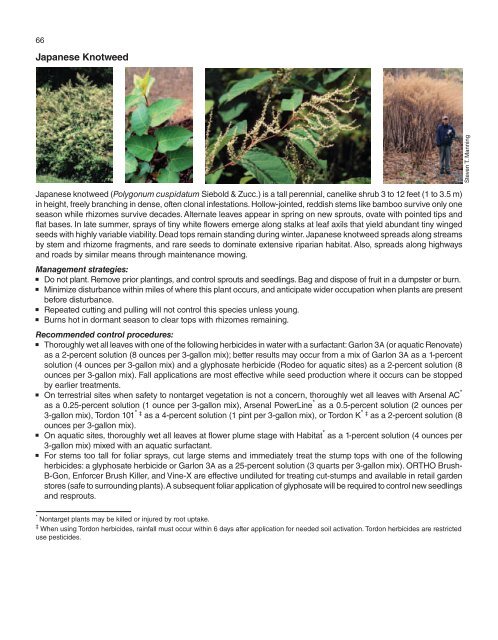A Management Guide for Invasive Plants in Southern Forests James ...
A Management Guide for Invasive Plants in Southern Forests James ...
A Management Guide for Invasive Plants in Southern Forests James ...
- No tags were found...
You also want an ePaper? Increase the reach of your titles
YUMPU automatically turns print PDFs into web optimized ePapers that Google loves.
66Japanese KnotweedSteven T. Mann<strong>in</strong>gJapanese knotweed (Polygonum cuspidatum Siebold & Zucc.) is a tall perennial, canelike shrub 3 to 12 feet (1 to 3.5 m)<strong>in</strong> height, freely branch<strong>in</strong>g <strong>in</strong> dense, often clonal <strong>in</strong>festations. Hollow-jo<strong>in</strong>ted, reddish stems like bamboo survive only oneseason while rhizomes survive decades. Alternate leaves appear <strong>in</strong> spr<strong>in</strong>g on new sprouts, ovate with po<strong>in</strong>ted tips andflat bases. In late summer, sprays of t<strong>in</strong>y white flowers emerge along stalks at leaf axils that yield abundant t<strong>in</strong>y w<strong>in</strong>gedseeds with highly variable viability. Dead tops rema<strong>in</strong> stand<strong>in</strong>g dur<strong>in</strong>g w<strong>in</strong>ter. Japanese knotweed spreads along streamsby stem and rhizome fragments, and rare seeds to dom<strong>in</strong>ate extensive riparian habitat. Also, spreads along highwaysand roads by similar means through ma<strong>in</strong>tenance mow<strong>in</strong>g.<strong>Management</strong> strategies:Do not plant. Remove prior plant<strong>in</strong>gs, and control sprouts and seedl<strong>in</strong>gs. Bag and dispose of fruit <strong>in</strong> a dumpster or burn.M<strong>in</strong>imize disturbance with<strong>in</strong> miles of where this plant occurs, and anticipate wider occupation when plants are presentbe<strong>for</strong>e disturbance.Repeated cutt<strong>in</strong>g and pull<strong>in</strong>g will not control this species unless young.Burns hot <strong>in</strong> dormant season to clear tops with rhizomes rema<strong>in</strong><strong>in</strong>g.Recommended control procedures:Thoroughly wet all leaves with one of the follow<strong>in</strong>g herbicides <strong>in</strong> water with a surfactant: Garlon 3A (or aquatic Renovate)as a 2-percent solution (8 ounces per 3-gallon mix); better results may occur from a mix of Garlon 3A as a 1-percentsolution (4 ounces per 3-gallon mix) and a glyphosate herbicide (Rodeo <strong>for</strong> aquatic sites) as a 2-percent solution (8ounces per 3-gallon mix). Fall applications are most effective while seed production where it occurs can be stoppedby earlier treatments.On terrestrial sites when safety to nontarget vegetation is not a concern, thoroughly wet all leaves with Arsenal AC *as a 0.25-percent solution (1 ounce per 3-gallon mix), Arsenal PowerL<strong>in</strong>e * as a 0.5-percent solution (2 ounces per3-gallon mix), Tordon 101 * ‡ as a 4-percent solution (1 p<strong>in</strong>t per 3-gallon mix), or Tordon K * ‡ as a 2-percent solution (8ounces per 3-gallon mix).On aquatic sites, thoroughly wet all leaves at flower plume stage with Habitat * as a 1-percent solution (4 ounces per3-gallon mix) mixed with an aquatic surfactant.For stems too tall <strong>for</strong> foliar sprays, cut large stems and immediately treat the stump tops with one of the follow<strong>in</strong>gherbicides: a glyphosate herbicide or Garlon 3A as a 25-percent solution (3 quarts per 3-gallon mix). ORTHO Brush-B-Gon, En<strong>for</strong>cer Brush Killer, and V<strong>in</strong>e-X are effective undiluted <strong>for</strong> treat<strong>in</strong>g cut-stumps and available <strong>in</strong> retail gardenstores (safe to surround<strong>in</strong>g plants). A subsequent foliar application of glyphosate will be required to control new seedl<strong>in</strong>gsand resprouts.* Nontarget plants may be killed or <strong>in</strong>jured by root uptake.‡ When us<strong>in</strong>g Tordon herbicides, ra<strong>in</strong>fall must occur with<strong>in</strong> 6 days after application <strong>for</strong> needed soil activation. Tordon herbicides are restricteduse pesticides.
















